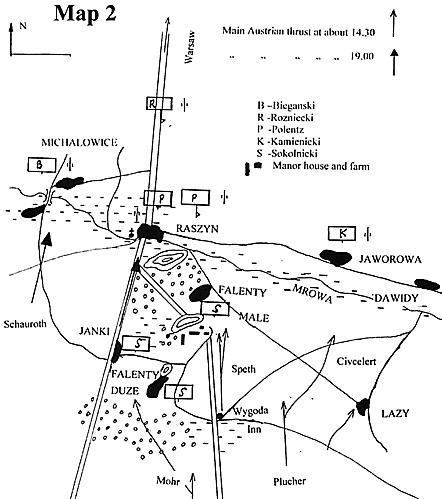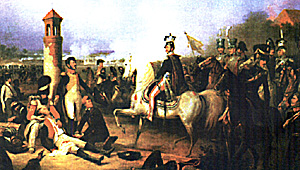The Battle of Raszyn
April 19, 1809
The Battle
by A. Ricciardielo, Poland
| |
Wednesday 19th April was a bright sunny day, and in the morning the Poles deployed themselves as follows (map 2); Roznicki's cavalry, 1st, 3rd plus 4 horse guns at the front of the main position; 3rd and 6th someway to the north east and 2 squadrons 2nd by the Wygoda Inn, whilst another squadron of the 2nd were behind the Mrowa. In all about 2,400 troopers. Sokolnicki had 1st battalion/1st regiment (850 men) by Falenty Male with 4 guns, later 6. These were at the beginning of the dyke, and before Falenty Duze, 1/8th (760.) To the north east of Janki stood the 1/6th (810) with 2 guns. The main position was behind the Mrowa centred on Raszyn under Poniatowski's direct command, i.e., 1/2/2nd and 2 guns on the west of the town, 12 Saxon guns either side of it and 1 Saxon hussar squadron to the east. The Saxons were under the command of Polentz. In total about 3,700 men. On the right flank a low bill just south west of Michalowice was Bieganski, (1,740) with 1/2/3rd and 2 guns and 2 howitzers. The left wing under Kamienicki (1,700) stood at Jaworowa, where he had 2/1 and 2/8h with 6 guns. The reserve was made up of the 1st Chasseurs with 5 horse guns, the total army strength coming to some 13,500 in 12 battalions, 14 squadrons and 39 pieces. (Some troops had been sent to Warsaw to garrison it and to extreme flank positions) The Austrians marching along the two main roads had divided themselves into 3 groups. A vanguard under Mohr was 5520 strong with 12 guns. They also had two cuirassier regiments marching along their flank. The main body was 17700 strong in 3 brigades plus cavalry and was commanded by Mondet. The last group under Schauroth was 3200, plus 6 guns strong. In all 28,000 men in 23 battalions, 36 squadrons and 86 guns. It was Mohr's hussar brigade that opened up the fighting on that day as they made their way to Nadarczyn They skirmished with Roznicki's lancers and although inflicting losses the Poles had to retire so as not to be outflanked by a regiment marching from Tarczyn, and Mohr to Falenty. Around midday Mohr reached Lesznowole where he found Roznicki's lancers and a few guns by the Wygoda Inn. Rather than scattering this force with his 8 sqds, 5 battalions and 2 batteries, he contented himself with waiting for Speth moving from Lazy, moving forward 3 squadrons and placing a battery on the hills behind Lesznowole. D'Este was pleased to see the Poles wanting to put up fight and thus giving him the decisive battle he wanted. His first orders were to put together the hussars and cuirassiers (Mohr and Speth) about 20 squadrons to be backed up by Vukossovich's regiment, 2 Wallachian regiments and 2 batteries. In addition 6 battalions of Civcerlert's brigade and Pflecher's brigade, another 6 battalions were put into motion. Schauroth covered from Nadarzyn with 3 squadrons of hussars and 4 infantry companies from Vukassovich and a horse battery. After skirmishes that lasted half an hour Roznicki noticed Mohr's infantry and a battery emerging from the woods. He slowly retreated to Janki where in accordance to orders he went through Michalowicz to form the last line, detaching some elements to the flanks. The First StageAfter the Austrians got themselves into position, fighting erupted virtually all along the line at about 2 p.m. The initial Austrian attack looked like this; the left under Civcelert comprised 6 battalions and 4 hussar squadrons attacked Jaworowa. The centre, Vukossowich with Mohr's men 5 battalions and 12 guns to engage Sokolnicki and onto Raszyn. The left, Schauroth to Michalowich. On the left the Palatinal hussars were shattered by the Polish artillery as they had to fall back into a marsh. A cuirassier regiment tried to circle the Poles from the east only to endure the same process as the hussars. The cavalry withdrew to the Tarczyn road. The Austrian infantry tried a frontal attack on Jaworowa whilst 2 Wallachian grenz battalions from Mohr moved into Dawidy attacking Kamienicki's left. The guns and musketry dissipated all of these attacks. Unfortunately one of the regiments that was shot up was mostly Polish in composition. In the centre Mohr was very quickly stopped by Sokolnicki's artillery at Falenty. Another 2 batteries and 6 battalions were sent to the sector to force the issue. Sokolnicki received only 2 more guns and yet his artillery managed to keep the Austrians at arms-length for an hour more. Looking for a more fruitful avenue, Vukassovich with 2½ battalions tried to move the attack to the left side, more through the wood which was easier than wading through the ponds and marshes. They attacked Colonel Godebski's 8th at Falenty Duze and hand to hand fighting ensued as they tried to break through. After 4 p.m., the much-reduced Poles had to make a fighting withdrawal to the dyke. Near Falenty Male as the 8th were falling back, General Fiszer was wounded and Godebski had his horse shot from under him. (He was fatally wounded shortly after). At this dramatic moment Poniatowski arrived with 1/1st. Pipe in mouth he grabbed a musket and personally led the counter-attack, pushing back the Austrians and retaking the position. The Austrians sent in another 2 battalions and for two more hours tried to take the wood. At 6pm more Austrian Battalions joined the fray with 2 of them getting in the gap between 1/8th and 1/6th, north of Janki. This forced Sokolnicki to withdraw to Raszyn down the dyke, covering the movement with 200 men. Austrian artillery fire in this action led to the abandonment of 2 guns. As this was taking place the 1/6th were evicted from Janki by Schauroth's division, and they in turn also fell back further to Raszyn. So far the main Austrian attack in the centre had been held off for more than four hours by a little more than two battalions. The attack on the right had been shot to pieces and the Austrian left was no more than a cameo role. The Polish vanguard position was lost, but the two battalions defending it were still in reasonable condition, if somewhat reduced in numbers. The Second StageThe Austrians followed along the dyke and forced back the last defenders to the south cast of Raszyn. Here the Austrians came up against the Saxon Einsiedel Grenadier battalion who were covered by buildings and held their fire until the last moment. In the second line were the 1/2/2nd with the guns. The Saxon artillery began to fire but it was not so effective as the artillery had been up to now in the covered area of the town, and so the infantry fell back onto the guns. Pressure mounted and each room in each building in that quarter became a fortress. Fresh battalions of Civcelert came into action further stepping up the pressure on the defenders. There was no succour for the defenders either, d'Este decided to turn the position on the Polish right by crossing the marshes. The ground was virtually impassable and many soldiers died in the ooze and muddy waters. They themselves did not directly effect a great deal but they tied up the Poles on that side of the field so they couldn't reinforce Raszyn. Poniatowski re-deployed the Saxon artillery and 4 guns under Pelletier (who was believed to be better trained than Polish Artillery specialists) this being now the last line of resistance. At approximately 8pm the Austrians broke through moving onto these guns. The gunners tore through the Austrian formations who had no back up from their artillery. (The ground was stopping it from being moved up). The Austrians bravely came on, sometimes in square! Poniatowski dismounted and cheered his men on, and personally directed the fire of the pieces. After yet another hour of murderous fire the Austrians started to fall back. Between 9 and 10pm Poniatowski counter-attacked and pushed the Austrians back to the dyke. The Poles got no further than this, and given the forces to hand on both sides and the length of fighting, Poniatowski was really forced to withdraw. Polish losses amounted to; 450 dead, 8 to 900 wounded and 43 prisoners. The Austrian losses: 2,500 killed and wounded. Poniatowski was temporarily obliged to give up Warsaw, and although he left the field, the manner in which he and the army fought against such odds brought no shame on anyone. In fact in May he went on to launch a very successful offensive, taking several fortresses and much territory, but that's another story. ConclusionsInitially d'Este was anxious in case the Poles might withdraw and not give him the decisive action he was seeking. At the same time he did not respect Poniatowski or the Polish army; and relied on the shear weight of numbers to break through to Warsaw expecting to brush aside his opposition. This clearly did not work. Indeed they did not seem to have a clear plan, and no back up alternatives in case of difficulties that they ended up encountering. The Austrians despite their losses, and their effort, especially in the final push against the Saxon guns did not exploit the break through at Raszyn. They had a further 6 battalions in the Trantenberg Brigade that did nothing the whole day, despite being seemingly obsessed with having a reserve. The difference in leadership is also marked. Poniatowski on more than one occasion was inspiring and led by example, back to the wall or not, something d'Este wasn't. Looking at the force at Poniatowski's disposal and the outcomes at each sector, it can be seen that he distributed them in a sound manner and reinforced them as best as was possible at the right time, unlike the Austrians. They moved into situations, often piecemeal, under what seems to have been the nearest available commander. As said, despite leaving the field Poniatowski achieved a great deal. His army retired fatigued, but effectively intact and in good order. This must have been of immeasurable value in morale and confidence to the young army, himself and the country as a whole. Furthermore he learned exactly what he was up against, and very importantly shattered the Austrian certainty of victory. It can be said that the Polish successes on the field that day came down largely to the high morale and enthusiasm of the rank and file, the leadership, but also the terrain chosen that effectively channelled the Austrians onto the defenders, slowing and disordering them, giving ample opportunities to the Polish gunners. ReferencesMorawski. R. & Wielecki. H., Wojsko Ksiestwa Warszawskiego. Vol 1.
 Battle of Raszyn: Introduction Back to Table of Contents -- First Empire #58 Back to First Empire List of Issues Back to MagWeb Master Magazine List © Copyright 2001 by First Empire. This article appears in MagWeb (Magazine Web) on the Internet World Wide Web. Other military history articles and gaming articles are available at http://www.magweb.com |
 The death of Cyprian Godebski at Raszyn
The death of Cyprian Godebski at Raszyn